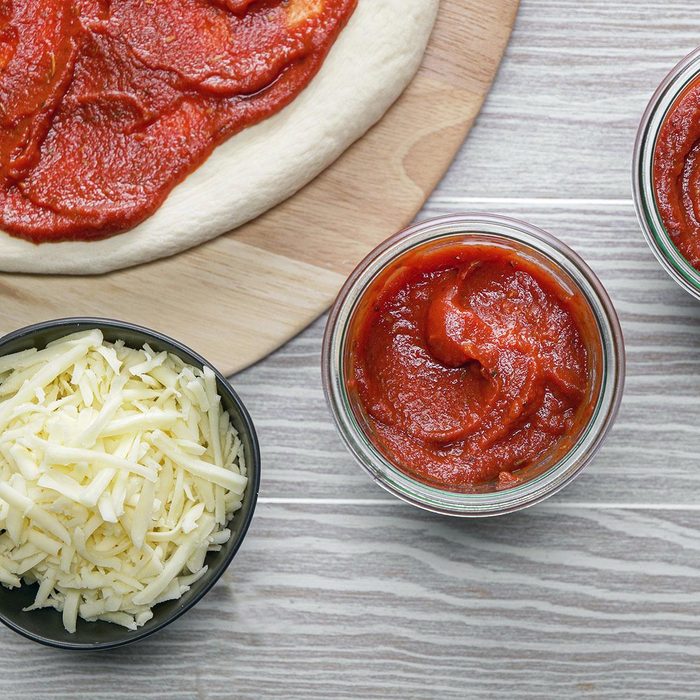Pizza night at home is always a blast, and making your own pizza is a great way to save money on this delicious ritual. Store-bought pizza sauce is certainly convenient for any DIY pizza night, but jarred sauces often lack the depth and complexity of the sauces served at your favorite Italian restaurant. Luckily, a homemade pizza sauce is neither difficult nor time-consuming, and you can really taste the difference. Our pizza sauce recipe is ripe with fresh tomato flavor and an aromatic backbone of Italian herbs and spices.
Another perk of making your own sauce is the customization you have at your fingertips. This pizza sauce recipe contains no added sugars and is made with plant-based ingredients, so you can use it to make vegan and dairy-free pizzas. You can also tailor the amount of salt and spices you use based on your health needs or culinary preferences.
Come pizza night, when you’re ready to assemble your beautiful ‘za, simply spread your pizza sauce over a thin crust pizza dough, and add your favorite pizza toppings.
Ingredients for Pizza Sauce
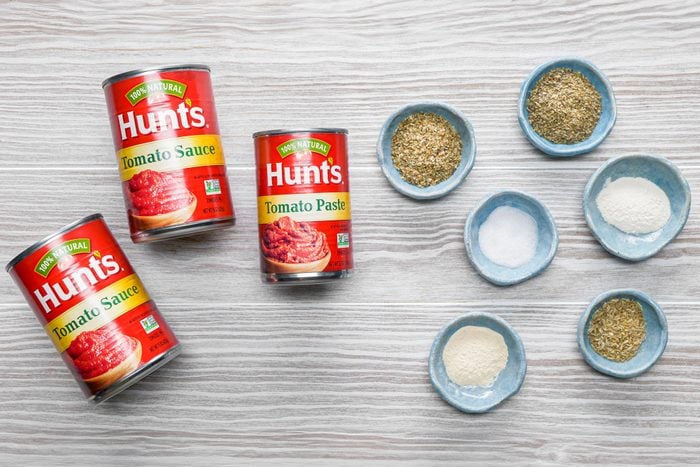
- Tomato sauce: Use canned tomato sauce (usually found next to the diced and crushed tomatoes) instead of jarred tomato sauce from the pasta aisle. It’s less expensive, and it tastes fresher.
- Tomato paste: Tomato paste is very concentrated because the tomatoes have been cooked until almost all the water is evaporated. Tomato paste is responsible for creating the rich, bold tomato flavor in pizza sauce. It also gives the sauce a thick body that keeps the pizza from getting soggy.
- Fennel seed: You can leave the fennel seeds out if you don’t have them on hand, but they do elevate the flavors in the sauce. Fennel seeds add earthy, licorice-like flavors and a touch of sweetness. Crush the fennel seed with a rolling pin, spice grinder or mortar and pestle.
- Seasonings: A combination of Italian seasoning, dried oregano, onion powder and garlic powder gives the sauce a rich, fragrant quality that can only be found in homemade pizza sauce.
Directions
Step 1: Combine the ingredients
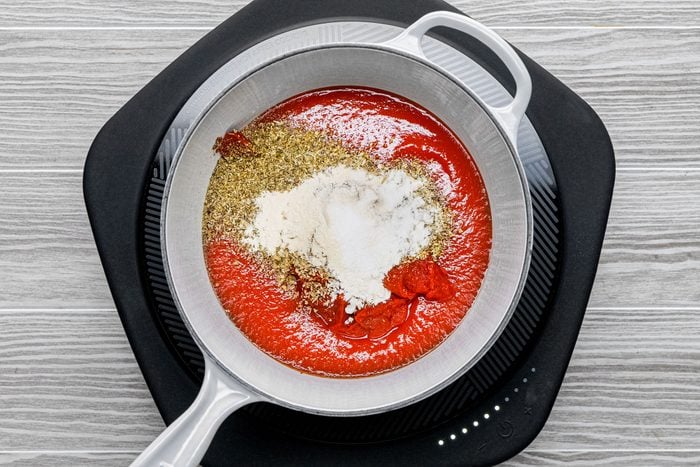
In a large saucepan over medium heat, combine the tomato sauce and paste. Add the Italian seasoning, dried oregano, crushed fennel seed, onion powder, garlic powder and salt. Mix well.
Step 2: Simmer the pizza sauce
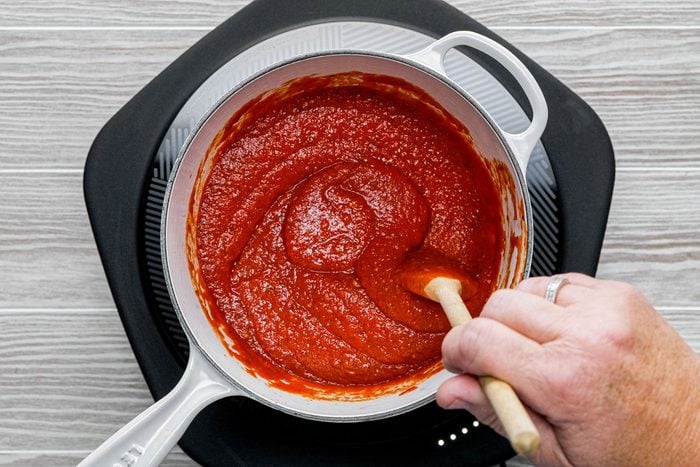
Bring the mixture to a boil, stirring constantly. Reduce the heat. Cover and simmer for one hour, stirring occasionally.
Editor’s Tip: Let the pizza sauce cool slightly before you use it on pizza dough. Adding hot sauce to raw pizza dough can make the dough soggy (yuck).
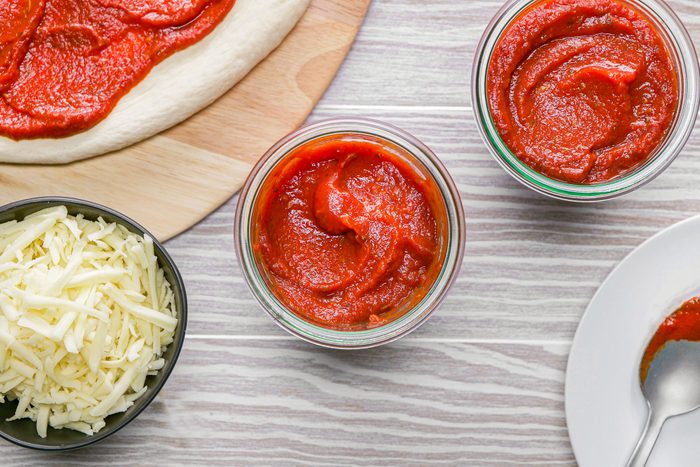
Recipe Variations
- Sub out the tomato sauce: Crushed tomatoes are a good substitute. These semi-pureed tomatoes in tomato sauce are commonly used to make thick marinara sauce recipes like pizza or pasta sauce. You can also puree your own canned tomatoes in a blender. Whole peeled tomatoes work best. In a pinch, diced tomatoes also work. Diced tomatoes are treated with calcium chloride to make the chopped tomatoes extra firm. Without blending, they won’t fall apart while the sauce simmers.
- Make it spicy: Include a pinch of crushed red pepper flakes to give the sauce a hint of spice.
- Use fresh garlic and onions: Instead of onion and garlic powders, saute chopped onions and minced garlic in butter or olive oil. Then add the tomato sauce and paste, and proceed as directed. Blend the finished sauce with an immersion blender to make the sauce as smooth as the original.
- Experiment with herbs: Feel free to add other dried herbs, such as basil, marjoram or thyme. If you prefer to add fresh chopped herbs, such as parsley or basil, add them during the last five minutes.
- Include a pinch of sugar: Some tomatoes are more acidic than others. Feel free to add a pinch of sugar if the sauce doesn’t taste balanced.
- Add richness: Give the pizza sauce a fuller texture by adding a little fat. Once the sauce is finished simmering, drizzle a little olive oil or pat of butter into the sauce. Stir constantly until well incorporated.
How to Store Pizza Sauce
This recipe isn’t approved for canning like homemade canned spaghetti sauce, so you’ll want to store it in the refrigerator or freezer. Use a container with a tightly fitted lid. It’s best to store the tomato sauce in glass jars or containers. The tomatoes are very acidic and tend to stain plastic containers. With proper storage, homemade pizza sauce will last for up to four days in the refrigerator.
How to Freeze Pizza Sauce
To freeze pizza sauce, let it cool completely in the refrigerator. Portion it into jars or freezer containers, leaving 1/2 inch headspace. Freeze for up to 12 months. Thaw frozen sauce in the refrigerator before using.
Can you make pizza sauce ahead of time?
Yes, pizza sauce is a great make-ahead recipe. The sauce can be easily doubled or tripled. Once made, store the pizza sauce in the refrigerator, or freeze it for extended storage.
Pizza Sauce Tips
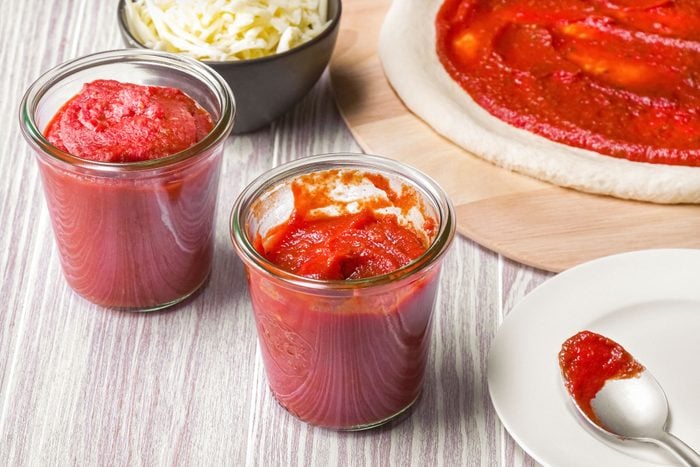
What are the best tomatoes to use for pizza sauce?
Plum tomatoes make the best pizza sauce, and San Marzano tomatoes are our favorite choice for pasta and pizza sauces. They are bright and slightly sweet. They’re also low in acidity, perfect for no-sugar pizza sauce recipes.
Can you use fresh tomatoes to make this pizza sauce recipe?
Yes, you can substitute fresh tomatoes in this pizza sauce recipe. Start with quartered plum tomatoes—seeds, skin and all. This saves the step of peeling and deseeding. Simmer the tomatoes in water for an hour until they’re completely soft, like we do in this marinara sauce recipe. Then press the tomato mixture through a food mill, and discard the skins and seeds. Return the tomato mixture to the saucepan, and proceed as directed.
How many pizzas can you make with this pizza sauce recipe?
The number of pizzas you can make with this pizza sauce recipe depends on the pizza dough size and your sauce preference. If you use 1/2 cup sauce per 12-inch pizza, this 4-cup recipe could make up to eight pizzas.




















